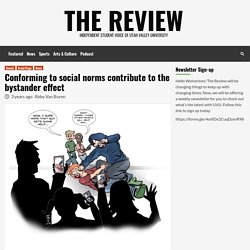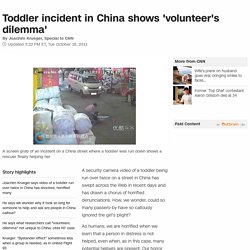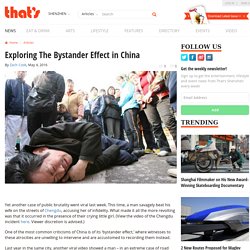

As such, if there are a greater number of bystanders, the less likely it is for any one of them to provide help to a person in distress.
People are also more willing to help others when there are fewer bystanders around.
This is also known as the diffusion of responsibilities.
How The Murder Of Kitty Genovese Created The Bystander Effect. Wikimedia CommonsKitty Genovese whose muder would inspire the psychological phenomenon known as the bystander effect.

At approximately 3:15 a.m. on March 13, 1964, a woman was murdered. Her name was Kitty Genovese. She was 28 years old, “self-assured beyond her years,” and had a “sunny disposition.” However, on that Friday evening, none of that mattered. As Kitty Genovese was stabbed to death in an alleyway outside her home, the friends and neighbors she had lived next to for several years stood by, choosing not to get involved as she lay there dying. Around 2:30 a.m. on the night of her attack, Kitty Genovese left the bar she worked at and headed for home.
A few minutes after she left, she stopped at a traffic light. At 3:15, Genovese pulled into the parking lot of the Kew Gardens Long Island Rail Road station parking lot, which was about 100 feet from her front door. Getty ImagesKitty at work at Ev’s bar. Example. What Is the Bystander Effect? Bystander Effect - Definition, Examples and Experiment. Art print from my Same Thoughts series. Printed on. Conforming to social norms contribute to the bystander effect - THE REVIEW. Resisting norms will likely prevent dangerous situations Illustration by Tyler Carpenter Conformity, ambiguity and social and cultural norms are reasons people do not intervene, according to Ashley Larsen, the associate dean of students during the It’s On Us event Oct. 31 in the Student Life and Wellness building.

The bystander effect is a social phenomena that results in individuals being less likely to offer help to a victim when other people are present. “If you see other people not doing anything you are more likely not to do anything,” said Larsen. “Literally the more people that are around the less likely the individual is to step in and do something.” It’s On Us is a national movement focused on providing training and to ultimately end sexual assault. “Everyone usually feels like it is their responsibility to step in,” Larsen said. According to Larsen, intervening can prevent more discrete violence such as microaggressions or homophobic and offensive gendered remarks. An avoidable murder of a student caught on tape: the sickening power of the bystander effect.
On Sept. 17, the life of a 16-year-old high schooler in Long Island ended tragically in a violent brawl outside a strip mall.

Khaseen Morris was told to show up outside the mall at a certain time by several others his age, after he was seen walking home the girlfriend of another boy. Morris showed up and was immediately attacked by a group of five teenagers. Bystander inaction, like 7-Eleven assault, more likely with more witnesses, experts say - Chicago Tribune.
Toddler incident in China shows 'volunteer's dilemma'. A security camera video of a toddler being run over twice on a street in China has swept across the Web in recent days and has drawn a chorus of horrified denunciations.

How, we wonder, could so many passers-by have so callously ignored the girl's plight? Exploring The Bystander Effect in China – That’s Shenzhen. Yet another case of public brutality went viral last week.

This time, a man savagely beat his wife on the streets of Chengdu, accusing her of infidelity. What made it all the more revolting was that it occurred in the presence of their crying little girl. (View the video of the Chengdu incident here. Viewer discretion is advised.) One of the most common criticisms of China is of its ‘bystander effect,’ where witnesses to these atrocities are unwilling to intervene and are accustomed to recording them instead. Last year in the same city, another viral video showed a man – in an extreme case of road rage – repeatedly stomping a woman’s head into a busy highway where no one stopped to help.
China: Senior sues would-be Samaritan. At around 9:00 am on November 20, 2006 in the eastern city of Nanjing, a Ms.

Xu, now 65, was knocked down while trying to board a bus. Peng Yu, a 26-year-old man, as he got off at the station, saw Ms. Xu lying on the ground with her left collarbone fractured. This much is known; a lack of witness leaves what happened next embroiled in controversy. According to Peng, he helped elderly Ms. According to the Xus, as it was Peng Yu who knocked her down and then took her to the hospital for treatment, it is he who must take responsibility. On September 7, at the 4th session of the case, the district court finally released its verdict: Peng Yu, partially liable for the accident, would pay 45, 876.36 yuan (US$6,076) to Ms Xu.
Discussion on the Bystanders Effect in China. Overcoming the Bystander Effect. How to overcome the bystander effect. While most of us are sympathetic toward helping someone, the bystander effect can prevent us from stepping in.

The bystander effect is when a group of people sees a problem or someone in need, but no one does anything to help. Why don’t we help? One reason why people choose not to help is because they observe and follow what other people are doing. So if everyone is passing by and not paying attention, we conclude that what’s happening isn’t a big deal.